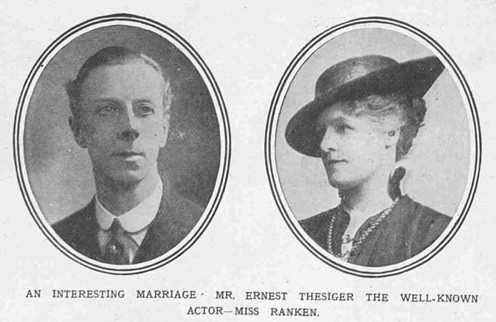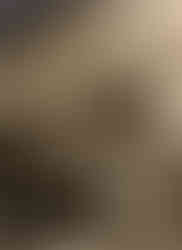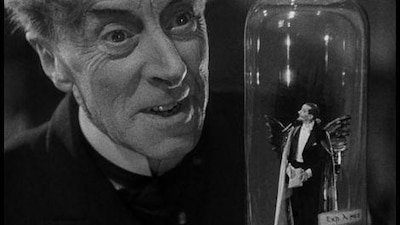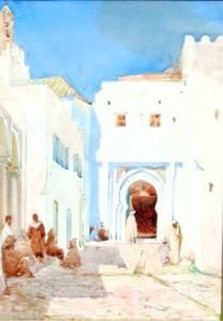
Ernest Frederic Graham Thesiger, CBE, born 15 January 1879, was an English stage and film actor. He is noted for his performance as Doctor Septimus Pretorius in James Whale's 1935 film Bride of Frankenstein.
Third of the four children of Hon. Sir Edward Peirson Thesiger, KCB, Clerk Assistant to Parliament, and Georgina Mary, daughter of William Bruce Stopford Sackville, of Drayton House, Thrapston, Northamptonshire, of the family of the Earl of Courtown, and grandson of the 1st Lord Chelmsford, Thesiger was born in London, England. He was the first cousin once removed of the explorer and author Wilfred Thesiger, and the nephew of the 2nd Lord Chelmsford.
Thesiger attended Marlborough College and enrolled at the Slade School of Art, London
originally training to be a professional fine artist, studying under Henry Tonks, but quickly switched to drama, making his professional debut in a production of Colonel Smith in 1909. In the early 1900s, Ernest traveled through Europe and as far as North Africa, producing landscapes in watercolor from locations in France, Italy, Corsica, Madeira, and Morocco. He continued to paint throughout his life, working primarily in watercolor.
He also protested with the Men's League for Women's Suffrage at the mass rally in 1909. While at the Slade School of Art, Ernest began a relationship with fellow student William Bruce Ellis Ranken which lasted throughout their lives. William painted a portrait of Thesiger and in 1911, John Singer Sargent created a charcoal drawing portrait of Thesiger.
After the outbreak of World War I, on 31 August 1914, he volunteered with the British Army's Territorial Force, enlisting into the 2nd Battalion of the 9th London Regiment (Queen Victoria's Rifles), as Rifleman No.2546 at its Regimental Headquarters in London's West End. After training in England for three months, he was sent to the Western Front in late 1914 with the Q.V.R.'s 1st Battalion. On 1 January 1915, he was wounded in the trenches, and medically evacuated back to England.
His interest in needlework had begun with buying and repairing pieces of historical embroidery with his brother in law William Ranken whilst in France. After an incident in a barn explosion, his hands had been damaged and on returning home, despite the Ministry of Pensions declaring it “too effeminate an occupation for men”, Thesiger developed small sewing kits for soldiers similarly injured to provide activity and pain relief. This became The Disabled Soldiers' Embroidery Industry, 42 Ebury Street, London. As Honorary Secretary Cross-Stitch, Thesiger was convinced that needlework could improve injured men's morale and earn some money, as he also obtained commissions, including an altar frontal for private use in Buckingham Palace. His other hobbies included paper craft (previously know as paper work.) His love of embroidery was a life long passion, as seen in the video below from British Pathé: Ernest Thesiger - Expert Embroiderer (1944).

In 1917, he married Janette Mary Fernie Ranken, sister of his close friend and fellow Slade graduate William Bruce Ellis Ranken. Janette was also an actress who worked under the name of Juliet Hardinge.
In her biography of Thesiger's friend, Ivy Compton-Burnett, Hilary Spurling suggests that Thesiger and Janette wed largely out of their mutual adoration of William, who shaved his head when he learned of the engagement.
William eventually came around and to commemorate his sister’s marriage, William painted this portrait of Janette, which unfortunately is now known only from this photograph. Another source states more explicitly that Thesiger made no secret of his bisexuality and that he had proposed a white marriage to Janette. At her brother's death in 1941, Janette Ranken gifted over 200 works to be distributed amongst English public galleries and museums, ensuring his legacy.
Thesiger first came to public notice in the farce A Little Bit of Fluff by Walter W. Ellis at the Criterion Theatre in 1915–18. He played the comic hero Bertrand Tully over 1,200 times, and received very favourable reviews. The London Standard wrote, “The character of Bertram Tully...is one of the happiest seen on the stage for a decade past...Mr. Ernest Thesiger achieved a real triumph.” He reprised the role in the 1919 film version, and in a 1923 revival at the Ambassadors Theatre.
In 1925, Thesiger appeared in drag in Noël Coward's On with the Dance, and later played the Dauphin in Bernard Shaw's Saint Joan, which has several revivals throughout the 1930s. This highlighted his ability to play camp-like roles, which would eventually catch the eye of the similarly camp-leaning James Whale. He wrote an autobiography Practically True, published in 1927, which covers his stage career. An unpublished memoir written near the end of his life is housed in the Ernest Thesiger Collection at the University of Bristol Theatre Collection.
Thesiger had made his film debut in 1916 in The Real Thing at Last, a spoof presenting Macbeth as it might be done by an American company, in which he did a drag turn as one of the Witches. Thesiger also played the First Witch in a 1941 production of Macbeth directed by John Gielgud. He performed more small roles in films during the silent era, but worked mainly on the stage.
He had a larger role in an early film for director Alfred Hitchcock, the silent Number 13 (1922), as Mr Peabody but this was never completed due to lack of funds.
When he appeared in a Christmas production of The Merry Wives of Windsor in 1919, Thesiger met and befriended James Whale. After Whale moved to Hollywood and had found success with the films Journey's End (1930) and Frankenstein (1931), the director was commissioned to direct the screen adaptation of J. B. Priestley's Benighted as The Old Dark House (1932), starring Charles Laughton in his first American film, together with top-billed Boris Karloff, Melvyn Douglas, Gloria Stuart, Raymond Massey and Lillian Bond. Whale immediately cast Thesiger in the film as Horace Femm, launching his Hollywood career. The Old Dark House is available to watch here.
The following year Thesiger appeared (as a Scottish butler) with Karloff in a British film, The Ghoul.
When Whale agreed to direct Bride of Frankenstein in 1935, he insisted on casting Thesiger as Dr. Septimus Pretorius, instead of the studio's choice of Claude Rains. Partly inspired by Mary Shelley's friend John Polidori and largely based on the Renaissance physician and botanist Paracelsus, it became Thesiger's most famous role. The film is available to watch on the Internet Archive.
Arriving in the United States for the filming of Bride of Frankenstein, Thesiger immediately set up a display in his hotel suite of all his needlework, each with a price tag, and during the making of the film he would work on needlework, one of his hobbies.

Originally cast to play the luddite sculptor Theotocopolous in H.G. Wells's Things to Come (1936), Thesiger's performance was deemed unsuitable by the author, and so was replaced by Cedric Hardwicke, although he was retained on the parallel production of Wells's The Man Who Could Work Miracles.
Around this same time Thesiger published a book, Adventures in Embroidery, about needlework.
The remainder of Thesiger's career was centered on the theatrical stage, though he did appear in supporting roles in films, prominent among which is The Man in the White Suit (1951), starring Alec Guinness. He plays “Sir John,” the most powerful, the richest, and the oldest of the industrialists (jointly with the trade unions) trying to suppress Guinness's invention of a fabric that never wears out and never gets dirty. He also made a notable appearance in 1953 in the Golden Globe-winning The Robe as the Emperor Tiberius.
Thesiger made several appearances on Broadway, notably as Jacques to Katharine Hepburn's Rosalind in the longest-running production of As You Like It ever produced on Broadway. Later films included The Horse's Mouth (1958) with Alec Guinness and Sons and Lovers (1960). In 1960, Thesiger was appointed a Commander of the Order of the British Empire (CBE). He was Vice Patron of the Embroiderers Guild.
His last film appearance was a small role in The Roman Spring of Mrs. Stone (1961) with Vivien Leigh and Warren Beatty. That same year he made his final stage appearance—a week before his death—in The Last Joke, with John Gielgud and Ralph Richardson. Shortly after completing it, Thesiger died in his sleep from natural causes on the eve of his 82nd birthday. His body was buried in Brompton Cemetery in London.
Reading Recommendations & Content Considerations




































































































































































































































































Comments